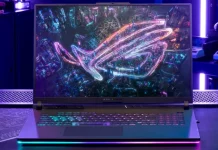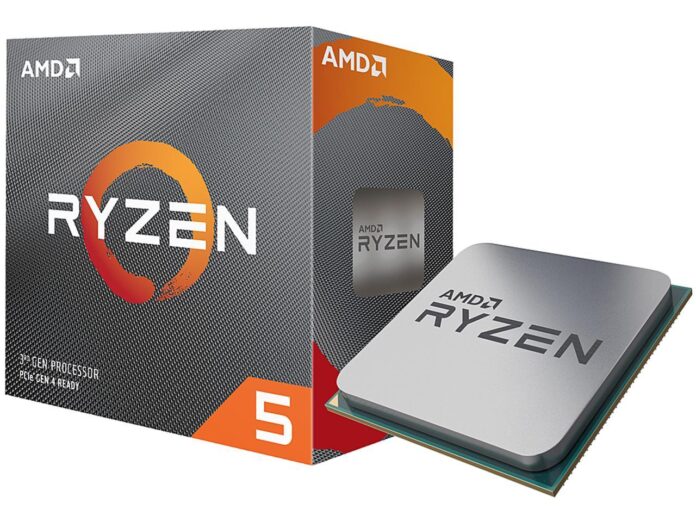AMD Ryzen 5000 series CPU’s have arrived
AMD’s Ryzen 5000 series CPUs have arrived, easily eclipsing Intel’s competing chips and bringing a new level of performance to the desktop PC with the flagship Ryzen 9 5950X and 5900X. With the complete disruption of Intel’s high-end chips already well in hand, AMD’s $300 Ryzen 5 5600X delivers a similarly stunning blow to Intel’s mid-range lineup and slots in as the mainstream chip for gaming – It even beats Intel’s $488 halo Core i9-10900K in 1080p gaming.
The Ryzen 5 5600X takes the mid-range by storm with six cores and twelve threads powered by the Zen 3 architecture fabbed on the 7nm process. That potent combination equates to a ~19% improvement in instruction per cycle (IPC) throughput, making the 5600X an easy choice for our list of Best CPUs. Other fine-grained improvements, like a vastly optimized boosting algorithm, improved memory overclocking, and reworked cache topology erases the last traces of Intel’s performance advantages while delivering a new level of power efficiency. In fact, as we’ll detail below, the Ryzen 5 5600X is the most power-efficient desktop PC chip we’ve ever tested.
But with the changing of the guard on the performance front, AMD has also changed its pricing as it assumes the position of being the uncontested premium brand. The company has raised pricing by $50 on all of its new chips, and for enthusiasts, that has a disproportionate impact on the Ryzen 5 5600X: Much to the dismay of AMD fans, the entry-level pricing for a new Zen 3 processor is an uncomfortably-high $300. However, despite the poor reception to AMD’s increased pricing, the Ryzen 5 5600X delivers more than enough performance to justify its price tag.
Much of Ryzen’s early success stemmed from industry-leading core counts and plenty of freebies for enthusiasts, like bundled coolers and unrestricted overclockability paired with broad compatibility. AMD still offers many of the same advantages, like unrestrained overclockability on all SKUs and most motherboards (the A-series is the lone exception), but has discarded bundled coolers for its Ryzen 9 and 7 processors. Luckily for entry-level buyers, the 65W Ryzen 5 5600X is the only Ryzen model that comes with a bundled cooler, and it’s adequate for most users.
| Zen 3 Ryzen 5000 Series Processors | RCP (MSRP) | Cores/Threads | Base/Boost Freq. | TDP | L3 Cache |
|---|---|---|---|---|---|
| Ryzen 9 5950X | $799 | 16 / 32 | 3.4 / 4.9 GHz | 105W | 64MB (2×32) |
| Ryzen 9 5900X | $549 | 12 / 24 | 3.7 / 4.8 GHz | 105W | 64MB (2×32) |
| Ryzen 7 5800X | $449 | 8 / 16 | 3.8 / 4.7 GHz | 105W | 32MB (1×32) |
| Ryzen 5 5600X | $299 | 6 / 12 | 3.7 / 4.6 GHz | 65W | 32MB (1×32) |
AMD also left a noticeable gap in its product stack – you’ll have to take a steep $150 step up the pricing ladder to get above the entry-level six-core twelve-thread Ryzen 5 5600X. AMD’s premium pricing could be a disadvantage against Intel if a price war forms, but AMD’s suggested selling prices rarely manifest at retail, and continuing shortages have found the chips selling far over recommended pricing. That makes it hard to predict how pricing will shake out over the next months.
According to our tests, the Ryzen 5600X delivers, though, beating Intel in nearly all metrics that matter, including performance, power consumption, and thermals, and largely removes Intel’s performance lead after overclocking. In fact, this $300 chip even beats Intel’s pricey flagship Core i9-10900K in most single-threaded workloads, and that’s after we overclock Intel’s silicon. And yes, the 5600X’s advantage over the 10900K includes 1080p gaming. You can take a broader look at how the full Zen 3 family stacks up against Comet Lake in our CPU Benchmark Hierarchy.
Meanwhile, Intel is left without a response until the first quarter of 2021 when its Rocket Lake chips blast off, bringing a new back-ported Cypress Cove architecture that grants a “double-digit” IPC increase paired with Intel’s never-ending 14nm process. In the meantime, we can expect further deep price cuts from Intel in response, particularly as Zen 3 availability becomes more plentiful.
For now, the Ryzen 5 5600X cements AMD’s Ryzen 5000 series as the uncontested performance leader in every price band it competes in. Let’s take a closer look.
Ryzen 5 5600X Specifications and Pricing
The Ryzen 5000 series processors come as four models that span from six cores and twelve threads up to 16 cores and 32 threads. AMD increased its Precision Boost clock rates across the board, with a peak of 4.9 GHz for the Ryzen 9 5950X.
Our Ryzen 9 5950X sample peaked at 5 GHz at stock settings, albeit sporadically, and reached 5.125 GHz after overclocking. We didn’t have as much luck with our Ryzen 5 5600X sample as we did with the 5950X, but the 5600X frequently beat it’s advertised 4.6 GHz boost clock with a 4.65 GHz boost on a single core.
AMD increased the boost clock speeds, but it also reduced base frequencies compared to the previous-gen processors. AMD says that if you top the chip with an adequate cooler, it will rarely (if ever) drop to the base frequency. We recorded many cases of a 4.55 GHz all-core boost with the Ryzen 5 5600X, which certainly wasn’t possible with the previous-gen chips. We’ll cover that more in-depth below.
| Zen 3 Ryzen 5000 Series Processors | RCP (MSRP) | Cores/Threads | Base/Boost Freq. | TDP | L3 Cache |
|---|---|---|---|---|---|
| Ryzen 9 5950X | $799 | 16 / 32 | 3.4 / 4.9 | 105W | 64MB (2×32) |
| Core i9-10980XE | $815 (retail) | 18 / 36 | 3.0 / 4.8 | 165W | 24.75MB |
| Ryzen 9 3950X | $749 | 16 / 32 | 3.5 / 4.7 | 105W | 64MB (4×16) |
| Ryzen 9 5900X | $549 | 12 / 24 | 3.7 / 4.8 | 105W | 64MB (2×32) |
| Core i9-10900K / F | $488 – $472 | 10 / 20 | 3.7 / 5.3 | 125W | 20MB |
| Ryzen 9 3900XT | $499 | 12 / 24 | 3.9 / 4.7 | 105W | 64MB (4×16) |
| Ryzen 7 5800X | $449 | 8 / 16 | 3.8 / 4.7 | 105W | 32MB (2×16) |
| Core i9-10850K | $453 | 10 / 20 | 3.6 / 5.2 | 95W | 20MB |
| Core i7-10700K / F | $374 – $349 | 8 / 16 | 3.8 / 5.1 | 125W | 16MB |
| Ryzen 7 3800XT | $399 | 8 / 16 | 3.9 / 4.7 | 105W | 32MB (2×16) |
| Ryzen 5 5600X | $299 | 6 / 12 | 3.7 / 4.6 | 65W | 32MB (1×32) |
| Core i5-10600K / F | $262 – $237 | 6 / 12 | 4.1 / 4.8 | 125W | 12MB |
| Ryzen 5 3600XT | $249 | 6 / 12 | 3.8 / 4.5 | 95W | 32MB (1×32) |
The 6-core 12-thread $299 Ryzen 5 5600X’s base clocks come in at 100 MHz less than the previous-gen 3600XT, while boosts are 100 MHz higher at 4.6 GHz. AMD’s 6C/12T Ryzen 5 3600XT had a 95W TDP, but AMD dialed that back to 65W with the 5600X, showing that Zen 3’s improved IPC affords lots of advantages. Despite the reduced TDP rating, the 5600X delivers explosive performance gains.
The Ryzen 5 5600X’s $300 price tag establishes a new price band for a mainstream processor, so Intel doesn’t have chips with nearly-identical pricing; the Core i5-10600K is the nearest Intel comparable. This chip carries a $262 price tag for the full-featured model, while the graphics-less 10600KF weighs in at $237.
Intel’s Core i7-10700K also isn’t nearly as fast as the 5600X in gaming and lightly-threaded work, and overclocking doesn’t change the story in any meaningful way. It does have two additional cores that might make it a compelling value alternative for content creation-focused tasks, but its $375 price tag makes that an iffy proposition. You’re better off stepping up another Ryzen tier.
But AMD does have a glaring hole in its product stack: You’ll have to shell out an extra $150 to step up from the $300 6C/12T Ryzen 5 5600X to the $450 8C/16T Ryzen 7 5800X, which is a steep jump. Based upon product naming alone, it appears there is a missing Ryzen 7 5700X in the stack, but it remains to be seen if AMD will actually bring such a product to market.
As before, AMD only guarantees its boost frequencies on a single core, and all-core boosts will vary based on the cooling solution, power delivery, and motherboard BIOS. The Ryzen 5 5600X is the only Ryzen 5000 chip that comes with a bundled cooler, and we found that the Wraith Spire delivers enough thermal headroom for most workloads, but you’ll get a boost from better cooling in heavily-threaded workloads. You also shouldn’t expect any meaningful overclocking headroom with the Wraith Spire cooler. More on that below.
The Ryzen chips continue to expose 20 lanes of PCIe 4.0 to the user and stick with DDR4-3200 memory as the base spec. However, if the silicon lottery shines upon you, we found that the chips offer much better memory overclocking due to improved fabric overclocking capabilities.
These chips drop into existing AM4 motherboards with 500-series chipsets, like X570, B550, and A520 models. AMD says it will also add support for 400-series motherboards starting in Q1, 2021, but that comes with a few restrictions. Regardless, some motherboard vendors have jumped ahead and are already offering support on 400-series motherboards, so that initiative is well underway. Just remember that you’ll lose support for the PCIe 4.0 interface on those older motherboards. Advertisementhttps://9af44f9522f88c852863e3b07bc53f8b.safeframe.googlesyndication.com/safeframe/1-0-37/html/container.html
We’ve covered AMD’s Zen 3 microarchitecture more in-depth in our Ryzen 9 5950X and 5900X review. The highlight reel is that AMD has unified its L3 cache into one 32MB contiguous cluster, which vastly reduces memory latency, thus boosting performance in latency-sensitive workloads, like gaming.
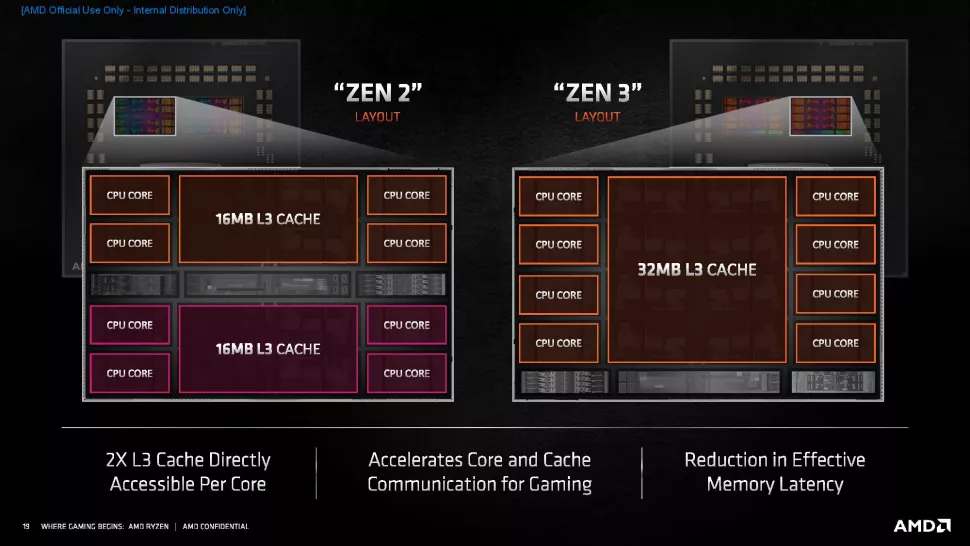
AMD leverages its existing Ryzen SoC for the 5000 series chips. Zen 3 uses the same 12nm I/O Die (IOD) paired with either one or two 8-core chiplets (CCD) in an MCM (Multi-Chip Module) configuration. For the Ryzen 5 5600X, the chip comes with one CCD with six cores enabled, while CPUs with 12 or 16 cores come with two chiplets.
The IOD still contains the same memory controllers, PCIe, and other interfaces that connect the SoC to the outside world. Just like with the Matisse chips, the IOD measures ~125mm^2 and has 2.09 billion transistors.
Test Setup and Ryzen 5 5600X Overclocking
We’ve included our test system breakdown at the end of the article, and we also have the frequency, boost, and thermal testing following the gaming and application testing below. Be sure to check those sections out.
Much like their previous-gen predecessors, the Ryzen 5000 series processors rarely achieve all-core overclocks that exceed the single-core boost frequency, so manual all-core overclocking results in less performance in lightly-threaded tasks. As such, we stuck with AMD’s Precision Boost Overdrive (PBO), which boosts performance in multi-core workloads while maintaining the high single-core boost clocks.
We’ve had great results with memory overclocking with the Ryzen 5000 series. However, while motherboard firmware is solid for stock and general overclocking use, it is still very much a work in progress for fabric overclocking. That impacts the peak memory frequencies you can attain while still using the 1:1:1 fclk/uclk/mclk ratio that provides the best results.
We’ve reached DDR4-4000 with a 2000 MHz fabric with other Ryzen 5000 processors, but we’re limited to a 1900 MHz fabric speed for the Ryzen 5 5600X. As such, we dialed in DDR4-3800 at 16-16-16-36 timings for our 5600X PBO configuration, and we dialed up the CCD and IOD voltage to 1.15V to stabilize the fabric frequency. We also tried overclocking with the Wraith Spire cooler, but were utterly unsuccessful. Plan on investing in a better cooler if you’re interested in overclocking.
We conducted all of our testing on the latest stable version of Windows 10 Pro (2004 build 19041.450) with the newest versions of each benchmark – with the exception of Cinebench R23 and v-ray 5, both of which launched last week. We’re already building out those results, which we’ll add in an update (soon). Advertisement
As a side note, there has been a surprising amount of coverage about the advantages of dual-rank over single-rank memory lately, but this is a known quantity. In fact, AMD itself revealed this in 2017, and we backed that up with our own testing for the Ryzen 3000 series last year. Yes, Ryzen continues to respond well to dual-rank memory and performance improves. Spoiler Alert: Similar gains apply to Intel chips, too. Our memory guru is conducting a round of testing on the new Ryzen 5000 and Intel chips with different ranks, stay tuned.
Ryzen 5 5600X Gaming Performance — The TLDR
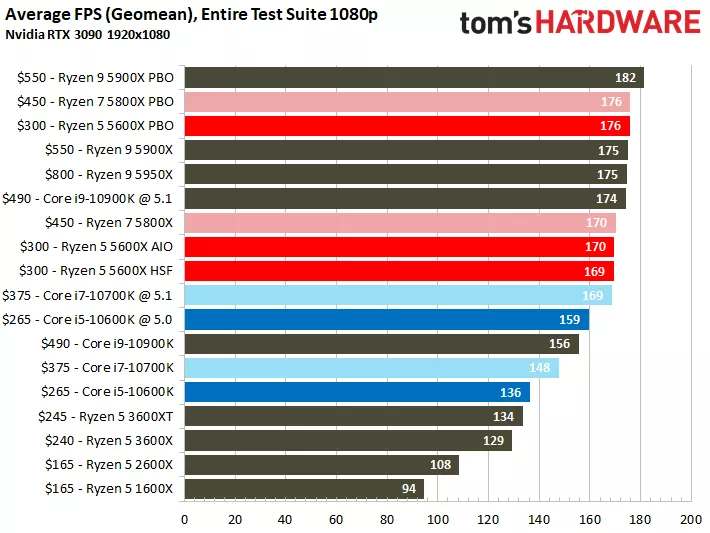
Here you can see the geometric mean of our gaming tests at 1080p and 1440p, with each resolution split into its own chart. We tested with an Nvidia GeForce RTX 3090 to reduce the impact of graphics-imposed bottlenecks. You’ll find the game-by-game breakdowns below.
We tested the Ryzen 5 5600X with both the bundled Wraith Stealth cooler (marked as HSF in the charts above) and the Corsair H115i 280mm liquid cooler (AIO) to measure the difference in gaming. As you can see, less than 1% separates the two coolers in gaming (those deltas are larger in our application testing), so we only included the tests with the H115i in the game-by-game breakdown below. Overall, the Wraith Spire cooler provides the same level of gaming performance in our test suite as the beefier AIO cooler.
For those leery of the Ryzen 5 5600X’s $300 price tag, look no further than Intel’s 10900K to see AMD’s justification. On a price-to-performance basis, the $300 Ryzen 5 5600X absolutely wrecks Intel’s halo $490 Core i9-10900K in our 1080p gaming suite. The 5600X even takes away the absolute performance crown, too. The 10900K is a bit more impressive in our 1440p suite, but not by much – it trails the 5600X at stock settings, and overclocking the 10900K only yields a scant 1 fps ‘advantage.’ Which is to say the chips are effectively tied.
The 5600X is even more impressive compared to chips in its price range. At stock settings, the Ryzen 5 5600X beats the stock Core i5-10600K in both 1080p and 1440p gaming by ~25% and 13%, respectively, both significant gains. Overclocking the Core i5-10600K to 5.0 GHz doesn’t help – the Intel chip still trails the stock 5600X by 7% at 1080p and effectively ties the 5600X at 1440p. As you would expect, overclocking the 5600X (PBO) yields an even larger advantage over the overclocked Intel chip. Advertisement
The $300 Ryzen 5 5600X is $35 more expensive than the Core i5-10600K, though, so we turn to Intel’s higher-end alternative, the $375 Core i7-10700K, to see how it fares against the 5600X. If gaming is your primary goal, paying $75 more for the 10700K than the 5600X is a waste of money. The stock 5600X beats the stock 10700K by 15% at 1080p, and ~8% at 1440p. Overclocking the 10700K doesn’t help, either – the stock 5600X ties the overclocked 10700K at 1080p and trails by a mere 3 fps at 1440p. Overclocking the Ryzen 5 5600X gives it the lead over the pricey 10700K silicon.
Finally, if you step up a tier to the $450 Ryzen 7 5800X, you won’t get much extra over the 5600X, at least as far as gaming is concerned. The Ryzen 5 5600X matches the overclocked Ryzen 7 5800X at both stock and overclocked settings in both resolutions, making it the new mainstream gaming champ.
One thing of note – the bottom four entrants of each chart cover AMD’s previous four generations of Ryzen 5 processors. Impressively, the Ryzen 5 5600X notches the largest performance delta over its immediate predecessor than any other Ryzen processor.
3D Mark, VRMark, Stockfish Chess Engine
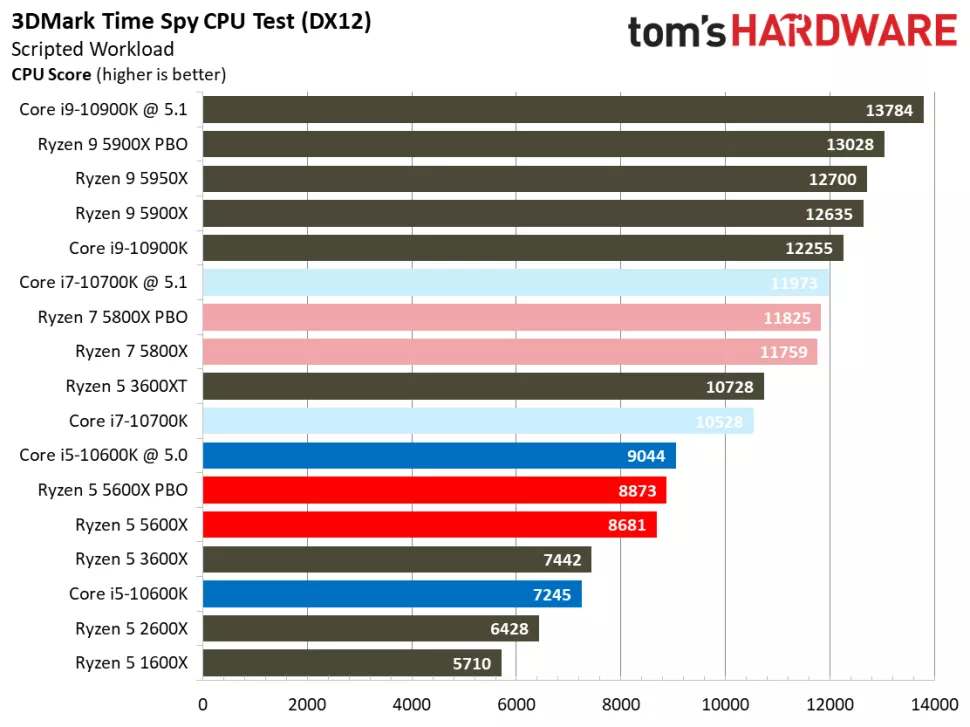
We run these synthetic gaming tests as part of our main application test script. We use an RTX 2080 Ti for these tests to facilitate faster testing, but we use an Nvidia GeForce RTX 3090 for all other gaming benchmarks (we don’t include these tests in the preceding cumulative measurements).
As we’ve come to expect, AMD’s core-heavy processors dominate in threaded synthetic tests, like the Stockfish chess engine and 3DMark’s DX11 and DX12 CPU benchmarks. The stock Core i5-10600K can’t hang with the stock Ryzen 5 5600X, and even overclocking the 10600K doesn’t allow it to keep pace in the DX11 and Stockfish tests. The overclocked 10600K does scrape past the 5600X in the DX12 CPU test, which leverages threading more effectively than the 3DMark DX11 benchmark.
As one would expect, the Core i7-10700K and Ryzen 7 5800X both lead the Ryzen 5 5600X in the DX12 and Stockfish tests, a byproduct of their higher core counts, but those gains don’t translate well (if at all) to the real-world gaming tests below. Advertisement
Perhaps the Ryzen 5000 processors are most impressive in VRMark. This benchmark leans heavily on per-core performance (a mixture of IPC and frequency), and as you can see from the previous-gen Ryzen processors, AMD has traditionally trailed in this benchmark. The Ryzen 5 5600X corrects that issue as it reaches the upper echelons of the chart, beating even the overclocked 10700K and 10600K by 20% and 8%, respectively – but that’s with the 5600X at stock settings. Overclocking the Ryzen 5 5600X yields a 24% and 14% advantage, respectively, over the tuned Intel processors.
Borderlands 3

AMD says that the Ryzen 5000 processors offer leading performance in a large number of titles. However, there will likely still be a period of time before we see targeted game updates to expose the best of Ryzen 5000, just like we saw with previous-gen Zen chips, so the gains don’t apply to all titles.
The Core i5-10600K trails the Ryzen 5 5600X by 4.6 fps at 1080p and 2.8 fps at 1440p. Overclocking the Ryzen 5 5600X delivers small gains at both resolutions, while the 10600K profits more from its 5.0 GHz clock speed, thus taking the lead in both benchmarks.
Far Cry 5
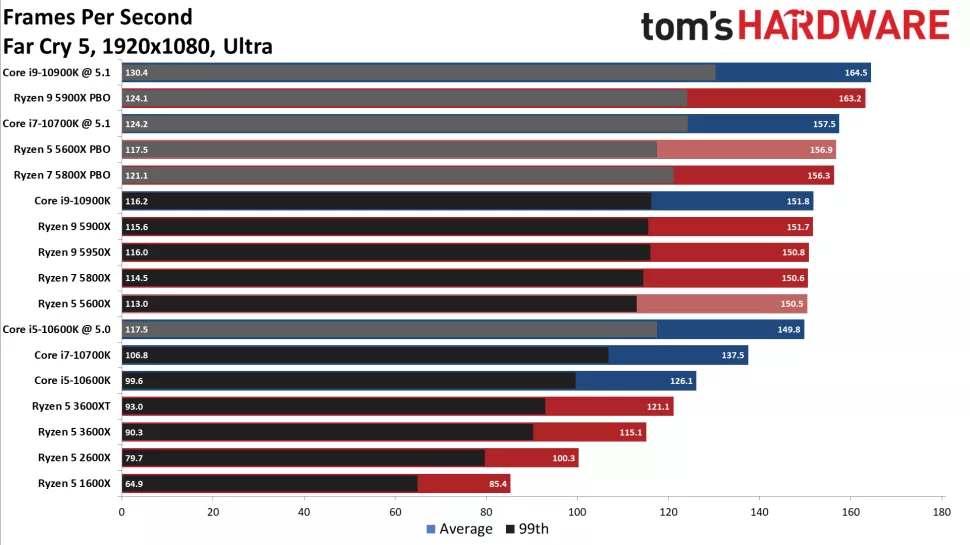
Far Cry 5 finds the Ryzen 5 5600X beating the Core i5-10600K across the board in both 1080p and 1440p benchmarks – and by significantly impressive margins. The Core i7-10700K also lags the 5600X significantly at stock settings, but effectively ties the 5600X after overclocking. Given the higher up-front pricing and pricey components needed to extract the best of the 10700K’s overclocking prowess, the tie actually isn’t very impressive. Advertisement
Again, a quick glance at the previous-gen Ryzen models, all of which populate the bottom of these charts, highlights the explosive performance gains of the Zen 3 architecture. AMD has come a long way since the 1600X, which was the first Ryzen 5 chip to hit the market.
Hitman 2
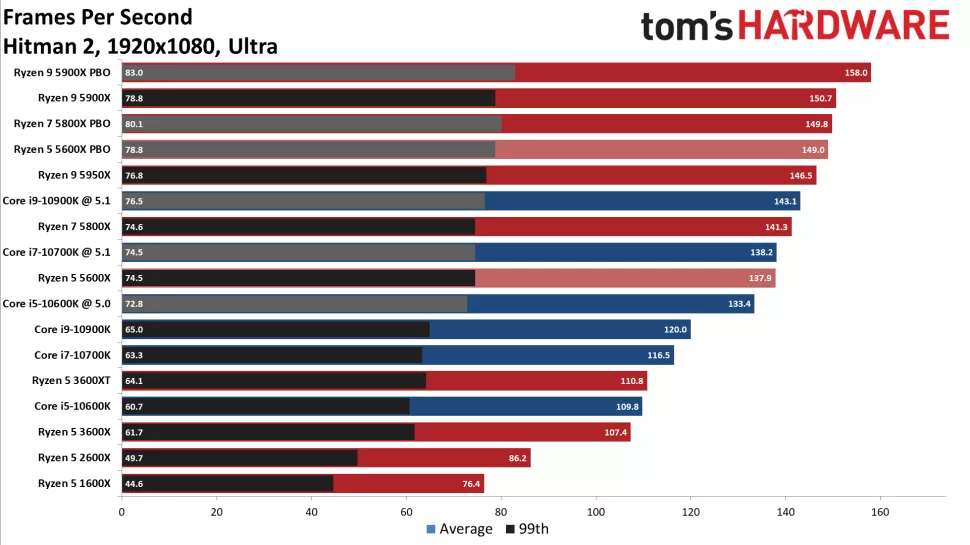
Hitman 2 doesn’t seem to scale well from 1080p to 1440p, at least not at the heightened fidelity settings we use for the benchmark. We stuck with the 1080p test for this title because the same trends carry over to 1440p.
The Ryzen 5000 processors dominate this benchmark – even the mighty Core i9-10900K, propelled by a prodigious amount of voltage and heat to 5.1 GHz, can’t match the overclocked Ryzen 5000 processors. Perhaps more impressively, the stock Ryzen 5 5600X beats all the Intel chips at stock settings, and ties the overclocked 10700K.
Microsoft Flight Simulator
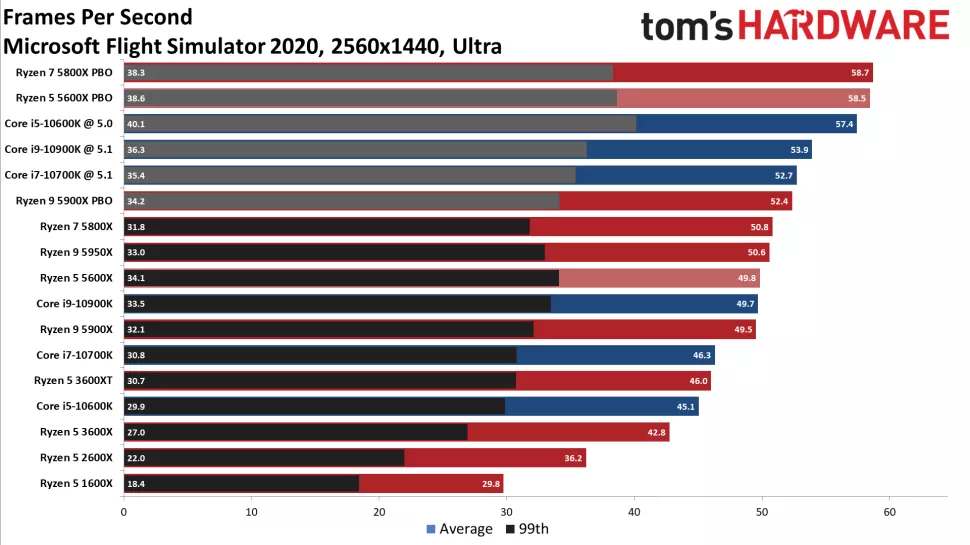
We’re just as excited as anyone else about Microsoft’s long long-overdue release of Flight Simulator, and we’re sure that serious flight sim fans will want to crank up the resolution on this title. Hence our tests at 1440p, which typically bring graphics bottlenecks into play. Expect these deltas to widen with 1080p testing. Advertisement
Impressively, the stock $300 Ryzen 5 5600X beats the stock Core i5-10600K and i7-10700K and matches Intel’s halo $490 Core i9-10900K. Turning the overclocking knobs on the Ryzen 5 5600X only cements its lead – the chip beats all of the Intel competition after overclocking, too.
Meanwhile, the Ryzen 7 5800X ekes out a small win over the 5600X at stock settings, but overclocking both chips yields an effective tie. Looking at this through the price-vs-performance prism, the Ryzen 5 5600X is the undisputed champ.
Project CARS 3
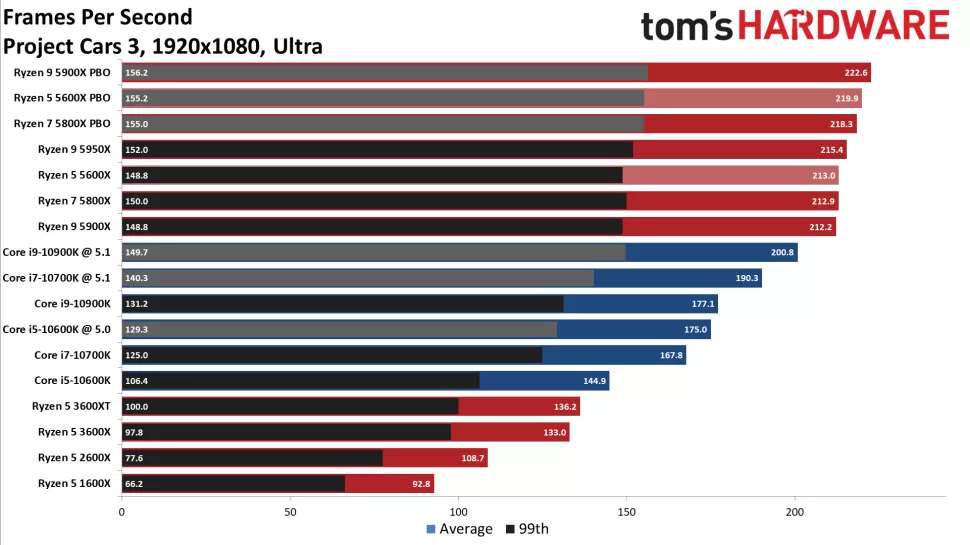
Project CARS 3 scales well with additional host compute, and the title obviously responds well to the Zen 3 architecture.
The stock Ryzen 5 5600X beats the Intel competition handily at the 1080p resolution. Again, we see the trend of the power-sipping stock Ryzen 5 5600X easily trouncing the overclocked Intel processors. The 5600X even scales well after tuning, propelling it near the top of the chart.
The trends we see at 1080p largely transfer over to the 1440p resolution, but the GPU bottleneck becomes apparent. Here the overclocked 10900K takes a slight edge, but the delta between it and the stock 5600X is fairly meaningless – you certainly won’t notice a little over 1 fps of difference. The looming graphics bottleneck also restricts the 5600X’s scaling with overclocking.
Red Dead Redemption 2

A glance at the bottom of these charts shows the clear progression of AMD’s architectures as it iterated on the Zen design. Still, in most of the titles we tested, the Ryzen 5000 series represents AMD’s biggest generational leap by far. Advertisement
Again, we see no-compromise 1080p gaming performance with the 5600X – even the heavily-overclocked Intel processors can’t overcome the advantages of the Zen 3 architecture paired with the 7nm process. A graphics bottleneck forms in the 1400p testing, but the 5600X still carves out a win over the Intel processors.
Shadow of the Tomb Raider
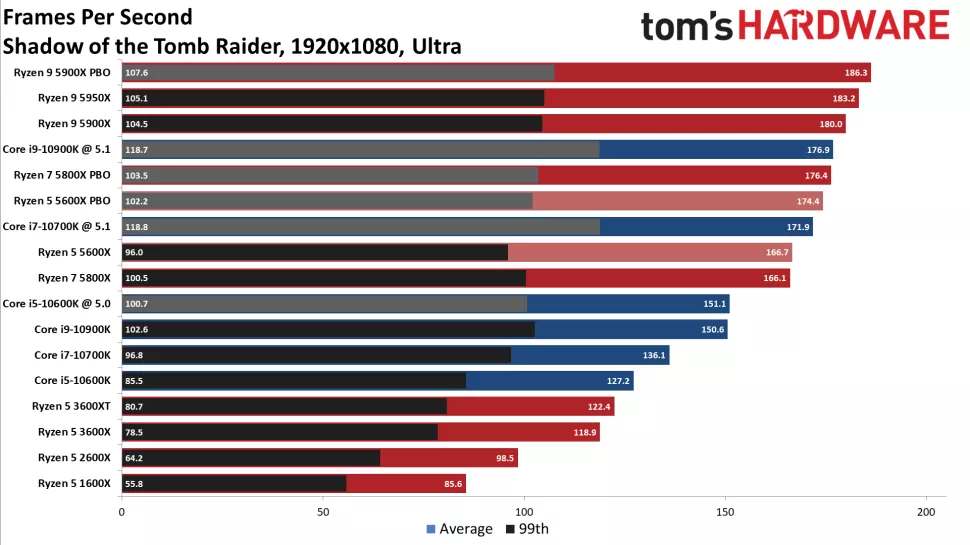
AMD’s chips take a sizeable lead at 1080p, but Intel’s overclocked chips deliver better 99th-percentile measurements. Flipping over to 1440p, Intel’s 10900K reaches the top of the chart, but it took quite a bit of voltage for it to surpass the stock Ryzen 5000 chips.
The Division 2
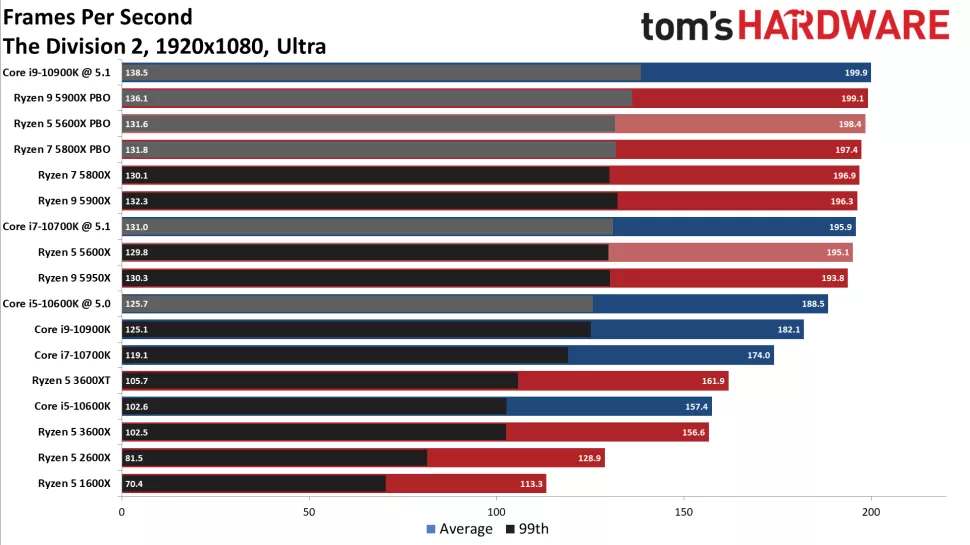
Ryzen 5 5600X Application Performance – The TLDR
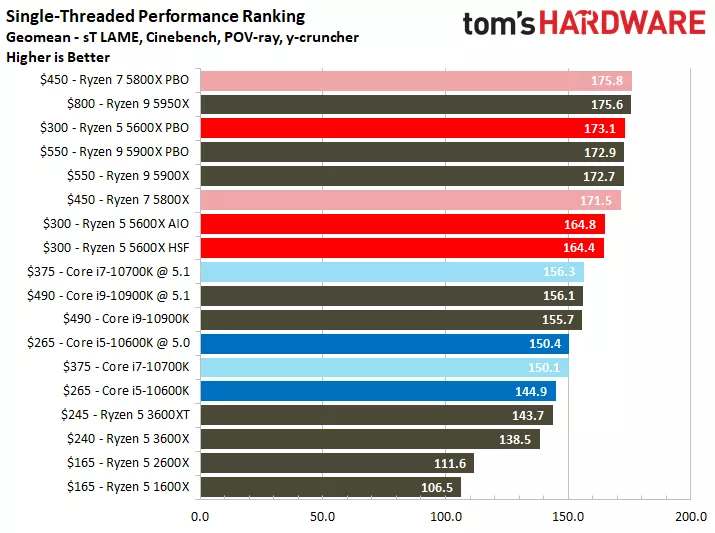
This geometric mean of both the most lightly- and heavily-threaded tests in our application suite speak volumes. We’re quite accustomed to seeing AMD’s chips lead in the multi-threaded rankings while trailing, sometimes by sizeable margins, in the single-threaded performance ranking. That isn’t the case anymore, and Zen 3 easily leads both rankings.
Again, we tested the Ryzen 5 5600X throughout our test suite with both a Corsair H115i water cooler (marked as AIO in the charts above) and the bundled Wraith Stealth cooler (HSF). As we saw in our gaming tests, there is little to no difference between single-threaded performance with the two coolers, but we see a bigger difference in our threaded applications. We recorded a 4% boost to performance with the H115i in our cumulative measure, but it’s important to note that this delta varies based on workload. The deltas range from 1% to 8% (worst case in one workload – y-cruncher), but to keep the charts clean, we’ve charted performance with our H115i cooler throughout the rest of the application testing.
However, regardless of the cooler, one thing remains true – the Ryzen 5 5600X easily beats the 10600K in threaded applications and even challenges the 10700K that comes with two more cores and a $75 premium, making the 5600X a solid bang-for-your-buck for heavy applications. If you need more performance and want to step up a tier, the Ryzen 7 5800X provides a solid boost through its additional two cores.
Moving over to the single-threaded performance rankings really highlights the 5600X’s strengths – the stock Ryzen 5 5600X beats the full roster of Intel chips, including the Core i9-10900K, in our ranking – and that’s even after we overclock the Intel chips to the limits of their 14nm silicon. The stock Ryzen 5 5800X is a nice step up from the 5600X for lightly threaded work, but overclocking both chips yields a small 1.5% advantage for the Ryzen 7 5800X. That isn’t a difference you’ll feel in any lightly threaded app, making the Ryzen 5 5600X the price-to-performance champ for lightly-threaded work, too.
Rendering Benchmarks
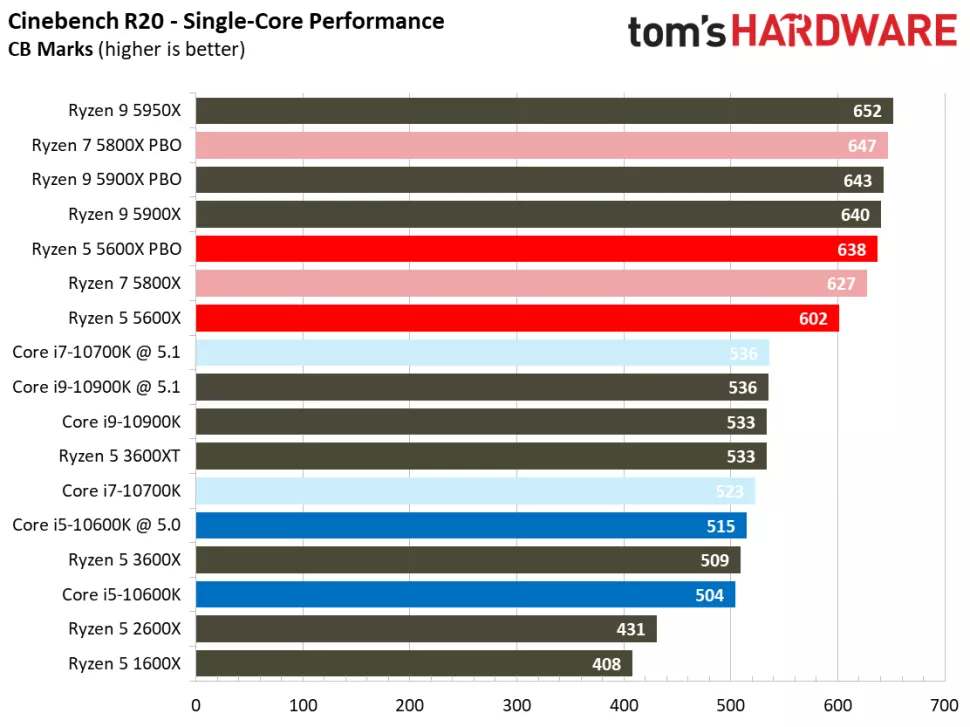
Cinebench has long been AMD’s favorite benchmark for a simple reason; the Zen microarchitecture has always performed extremely well in the threaded benchmark. However, AMD has steadily improved its performance in the single-threaded benchmark and slowly worked its way up the chart.
The 5600X flexes its single-threaded muscles in the Cinebench benchmark, and while it’s not as impressive as the 5800X, we also see significant uplift from overclocking. Meanwhile, the Intel chips can’t keep pace and trail by large margins, even after overclocking. Things change with the multi-core Cinebench test, which finds the 5600X outstripping the 10600K, but trailing Intel’s 10700K and the Ryzen 7 5800X by appreciable margins. That isn’t entirely surprising given those chips’ core count advantages.
Intel’s 10600K takes the lead in the single-threaded POV-Ray test, but the remainder of these tests favor the Ryzen 5 5600X, with Blender and v-ray being particular areas of strength.
We recently integrated the Intel Open Image Denoise Benchmark into our suite. This ray-tracing test uses Intel’s oneAPI rendering toolkit, so it provides an interesting take on performance. Here we can see that the 5600X beats the stock Core i5-10600K at stock settings in this admittedly Intel-favorable test. Overclocking grants the 10600K a slim lead.
Encoding Benchmarks
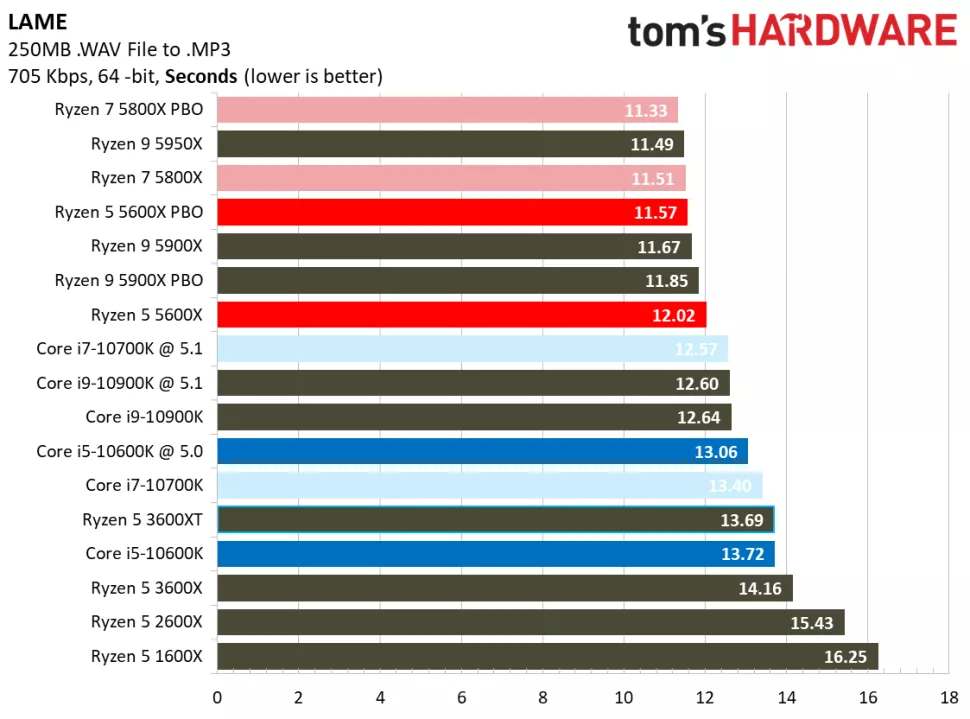
Our encoding tests include benchmarks that respond best to single-threaded performance, like the quintessential examples LAME and FLAC, but the SVT-AV1 and SVT-HEVC tests represent a newer class of threaded encoders. Regardless of the type of encoder, though, AMD’s Zen 3 chips impress. The Ryzen 5 5600X is no exception – it easily beats its nearest Intel competitor, the 10600K, across the board. The 5600X’s performance in HandBrake, in both AVX-light x264 and AVX-heavy x265 flavors, is incredibly impressive as it trades blows with the more expensive 10700K.
It’s quite shocking to see AMD’s reversal of fortunes in benchmarks like LAME and FLAC; a glance at the previous-gen Ryzen processors at the bottom of the chart shows the company’s rapid improvements over the last few years.
Web Browsing
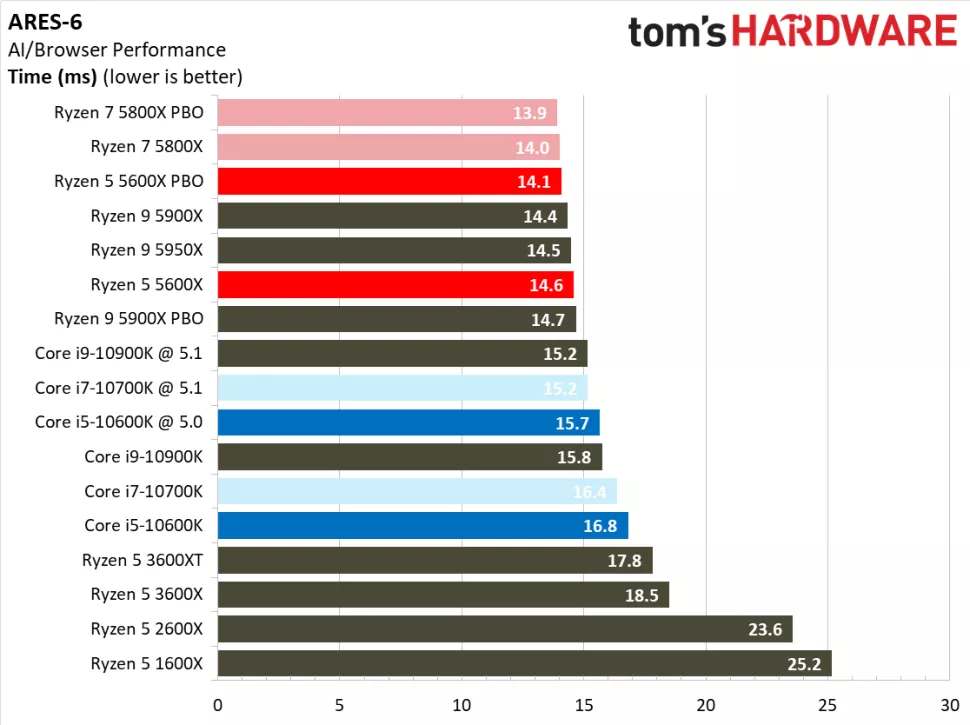
We test all of these benchmarks in a version-locked Chrome browser, with the notable exception of the Edge test. Intel has really taken quite the performance haircut in web browsers over the last two years, largely due to mitigations for its nagging security concerns.
Regardless, these benchmarks are almost exclusively lightly-threaded, so Intel has long held the top of the charts despite the mitigations. This series of benchmarks makes a powerful statement about Zen 3’s improved single-threaded performance, though. From the AI-heavy ARES-6 to WebXPRT3’s Javascript tests, and even extending to Jetstream 2, the Ryzen 5 5600X beats every overclocked Intel chip – but at stock settings. https://9af44f9522f88c852863e3b07bc53f8b.safeframe.googlesyndication.com/safeframe/1-0-37/html/container.html
Edge stands out as the lone exception – this browser leverages threading more effectively, so more cores generally equates to more performance. Intel’s heavily-overclocked 10700K nudges past the stock 5600X, but that’s not a meaningful victory – the overclocked Ryzen 5 5600X leads by a comparatively large margin.
Office and Productivity
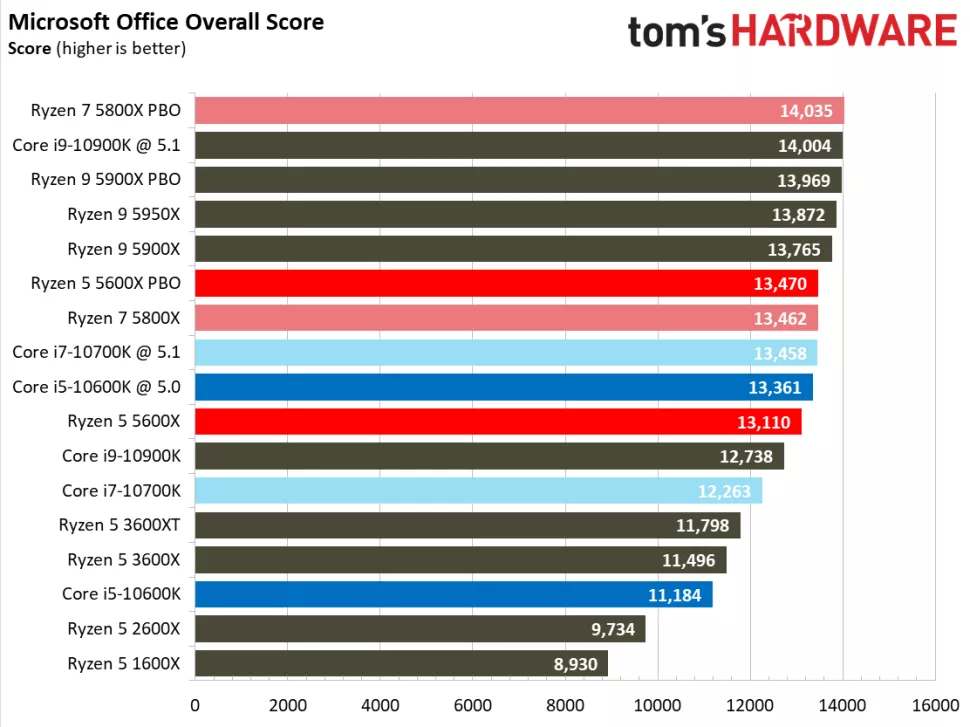
AMD’s Ryzen 5000: Come for the gaming and rendering performance, but stay for the Office experience? OK, probably not. If you’re looking to build a screaming-fast computer, you’re probably not doing it to run office applications like Word at breakneck speeds. However, these types of applications are ubiquitous the world over, and snappy performance is important for daily tasks. This is another area that AMD has long offered middling performance, but Zen 3 climbs the ranks impressively.
For a perfect example of how the Ryzen 5000 chips deliver new levels of snappiness, look no further than the application start-up benchmark. The Ryzen 5 5600X, again at stock settings, delivers a snappier experience than Intel’s overclocked chips. Given the performance we see from the prior-gen Ryzen chips in this chart, that’s nothing short of phenomenal.
You’d be hard-pressed to find any weakness with the Ryzen 5 5600X in this roster of tests – there simply isn’t one. Sure, it trails Intel’s far more expensive chips in a few threaded workloads, but that’s hardly a concern given the price point.
Compilation, Compression, AVX Performance
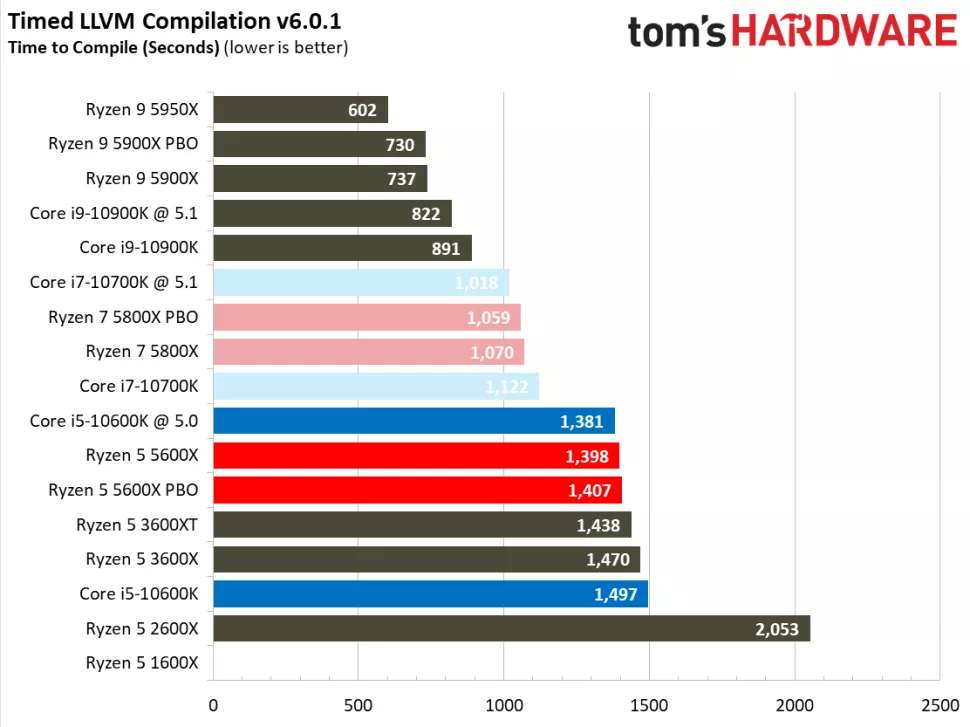
Advertisement
The LLVM compilation benchmark stresses the cores heavily with branchy code. Here we see that, like with the Ryzen 9 5950X and 3950X, the Ryzen 5 5600X doesn’t offer much performance uplift over the previous-gen Ryzen 9 3900XT. These muted gains imply that the bottleneck lies elsewhere, and we imagine that future software optimizations could yield larger performance deltas.
The threaded y-cruncher benchmark also revealed limited scaling for the 5950X over the 3950X. Given the memory-heavy nature of this workload, we theorized this boils down to the same limitation on both chips — a dual-channel memory controller that restricts feeding the 16 hungry cores. The Ryzen 5 5600X doesn’t suffer the same fate, though – it provides a more substantial amount of performance uplift over the previous-gen 3900XT, which likely stems from its better balance of per-core memory throughput.
We also see a strong uplift in NAMD, the gold standard for testing the performance of simulation code. Here the stock 5600X easily beats the overclocked 10600K, but we see a slight performance decline after engaging PBO. That isn’t entirely surprising, as this tendency does manifest in some workloads with prior-gen Ryzen chips, too. Particularly if they respond exceedingly well to higher clock rates.
You’ll also notice that the Ryzen chips outstrip the Intel series by massive margins in the hashing and AES encryption benchmarks. This comes as a byproduct of AMD’s hardware-accelerated encryption support, a feature that didn’t make its way into Intel’s Skylake microarchitecture.
Ryzen 5 5600X Power Consumption, Thermals
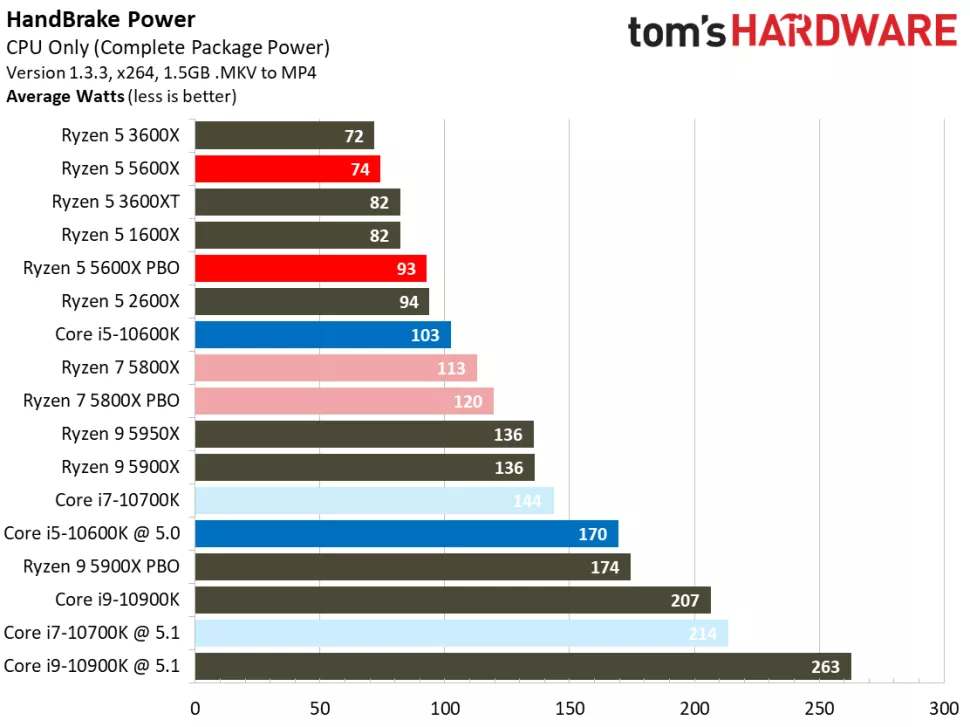
Notably, AMD’s decision to stick with the AM4 socket still constrains its maximum power consumption to 142W, which means that it could not increase power consumption for the new flagship models. However, Zen 3’s IPC gains allow the Ryzen 5000 chips to stay within the same TDP thermal and electrical ranges as the Ryzen 3000 series CPUs while delivering more performance.
Those same rules also apply to the 65W Ryzen 5 5600X – it must adhere to the same 88W PPT limit as its 65W predecessors. However, the previous gen Ryzen 5 models carried a 95W TDP rating, so their maximum power consumption metrics are higher.Advertisement
As you can see in the y-cruncher threaded benchmark results, the 5600X sips much less power than its predecessors, meanwhile delivering more performance. That’s the benefit of higher IPC, and thus more per-core performance.
The Ryzen 5 5600X does consume a few more watts than the 3600X during the Handbrake tests, but remains well below the 88W limit. The 5600X makes good use of that power, though, and delivers far more performance than its predecessors.
This combination leads to the highest level of power efficiency we’ve seen in our test suite – the Ryzen 5 5600X sets a new bar for power efficiency. In our renders-per-day-per-watt charts, you can see that the 5600X easily beats most of the field, though the Ryzen 9 5950X comes in at a close second. That’s incredibly impressive, and Intel’s chips are simply outmatched.
Intel’s chips are rather inefficient in comparison, which is a natural byproduct of using the older and less-dense 14nm node. Intel has also turned the dial up on the voltage/frequency curve to remain competitive, throwing efficiency out the window in exchange for higher performance.
The net-net is that the Ryzen 5000 processors will draw far less power per unit of work than any of Intel’s 14nm chips, which results in a cooler and quieter system.
Here we take a slightly different look at power consumption by calculating the cumulative amount of energy required to perform x264 and x265 HandBrake workloads and two Blender renders. We plot this ‘task energy’ value in Kilojoules on the left side of the chart.
These workloads are comprised of a fixed amount of work, so we can plot the task energy against the time required to finish the job (bottom axis), thus generating a handy power chart. Bear in mind that faster compute times and lower task energy requirements are ideal. Advertisement
This measure really separates the wheat from the chaff, and the best results fall to the lower left-hand corner of the chart. You’ll notice the modern Ryzen chips all populate the desirable bottom portion of the chart, while Intel’s power-hungry chips climb to the top of the chart. We can also see the clear progression through the various Ryzen 5 generations by looking at the Ryzen 5 1600X, 2600X, 3600X, and 3600XT as comparison points. Note that the stock 5600X sips less juice while delivering substantially faster performance than the Ryzen 5 3600XT – that’s an impressive generational improvement.
The Ryzen 5 5600X consumes an impressively low amount of power given its level of performance – the Core 5-10600K consumes far more power in exchange for slower performance. By virtue of its extra cores, Intel’s Core i7-10700K is faster than the Ryzen 5 5600X, but that comes at a hefty power expense – the 10700K consumes far more cumulative power than the 5600X.
Overall, the Ryzen 5 5600X sets the new bar for power efficiency, one that Intel won’t be able to match with any 14nm processor, including the pending Rocket Lake.
AMD Ryzen 5 5600X Boost Frequency, Power, Thermals
Here we’ll take a closer look at the Ryzen 5 5600X’s boost clock mechanisms. Our testing shows that the chips reach their advertised clock speeds within the power limits of the AM4 socket, but they generate quite a bit of heat in the process – especially if you use the bundled Wraith Stealth air cooler. The bundled air cooler doesn’t impact performance in light tasks, but if you do a lot of intense threaded work, like rendering or game streaming, the bundled air cooler leads to slightly reduced performance.
As per our normal routine, we put AMD’s boost clocks to the test in both single- and multi-threaded workloads (methodology here). The lightly-threaded test regimen is designed to extract the highest boost clock rates possible as we step through ten iterations of the LAME encoder, then single-threaded POV-Ray and Cinebench runs, PCMark 10, and GeekBench. To keep the charts ‘clean,’ we only plot the maximum and minimum frequency recorded on any one core during the test.
In the first slide in the album above, we chart out this series of tests at stock settings with the Corsair H115i 280mm air cooler. The chip peaked at 4.65 GHz, which is slightly above the advertised 4.6 GHz threshold. Temps topped out at 70C, which isn’t concerning.
Unlike with the Ryzen 3000 series processors, the unused cores (plotted in black) dropped as low as 2.2 GHz during the test (previous-gen chips tended to bottom out at 3.8 GHz). This is a big improvement over the previous-gen chips: AMD added the ability for individual idle cores to drop into sleep states quickly, which reduces overall chip power consumption and heat generation. By reducing this wasted layer of power consumption, the active cores can boost to higher frequencies and they can boost more frequently and for longer durations.
The second slide shows the same series of tests, but with the bundled Wraith Stealth air cooler. The air cooler still allows the processor to boost freely in these lightly-threaded workloads and we reach the same peaks of 4.65 GHz, but we see a marked increase in peak chip temperature to 81C during the tests, which is surprising given the relatively light nature of the tests. However, that increased heat output doesn’t appear to adversely impact boost frequencies or duration, but that changes when we stress the cores more fully in the tests below.
Ryzen 5 5600X Stress Test Frequency, Power, Thermals
The second series of tests plots our custom multi-threaded stress test that consists of multiple iterations of HandBrake, POV-Ray, Cinebench, v-ray, y-cruncher, and Blender renders. This is basically throwing the heaviest real-world workloads we have in our arsenal at the chip to see if we can push any active cores below the 5600X’s 3.7 GHz base clock. It’s important to note that all-core workloads that fully stress all the cores are represented in the areas where the red (maximum) and black (minimum) frequencies converge.
With the H115i AIO, the lowest all-core clock frequency we measured on fully active cores was 4.45 GHz, which is great considering the official 3.7 GHz base clock. Overall, all-core frequencies ranged from 4.65 GHz to 4.45 GHz. Temperatures were fine with the Corsair H115i cooler, peaking at 72C for short durations, albeit with the fans cranking away at high speed. AMD specs a maximum power draw (PPT – Package Power Tracking) of 88W for its 65W TDP processors. The 5600X peaked at 76W, meaning it has room to spare.
Temperatures were much higher with the Wraith Stealth air cooler, though: We measured sustained periods of 92C, and a peak of 95C, during the most intense portions of the test (Blender, POV-Ray, y-cruncher). This matches AMD’s 95C limit for 65W processors (105W processors have a 90C limit), but it does impact performance.
We can see that topping the 5600X with the Wraith Stealth cooler results in all-core frequencies that drop as low as 4.15 GHz, which is 300 MHz slower than the results with the H115i liquid cooler (but still well over the official 3.7 GHz base clock).
Naturally, that reduced frequency impacts performance. You’ll notice that our test run required an additional 60 seconds with the air cooler – a ~3% reduction in performance. However, this reduction varies, especially if the task consists of a fixed amount of work over an extended period of time, like a rendering workload.
Overall, the bundled Wraith Spire is more than sufficient for matching AMD’s spec’d clock rates in both single- and multi-threaded tasks, but the adaptive nature of Ryzen 5000’s Precision Boost algorithms will reward you with higher performance if you invest in a better cooler, particularly in heavily-threaded workloads.
We recorded higher temperatures during our tests than we’ve seen with previous-gen Ryzen chips, but, long story short, don’t get too excited about the higher stock temperatures. This is by design. AMD has tuned its boost algorithms to fully leverage every last bit of the thermal headroom available, resulting in higher chip temperatures – even during comparatively lighter workloads. This doesn’t pose any danger to chip longevity and ultimately results in better performance.
To help align expectations, AMD issued the above guidelines for expected temperatures for various kinds of coolers and the expected voltage ranges for various workloads. Naturally, lesser coolers at more mundane settings will peak at higher temperatures.
AMD’s Zen 3 Disruption is Nearly Complete
AMD’s flagship Ryzen 9 5950X and Ryzen 9 5900X utterly devastate Intel’s mainstream chips, but Intel doesn’t really have comparable chips that compete on mainstream platforms.
However, Intel does have competing models for the Ryzen 5 5600X. Our results show that AMD’s Zen 3 microarchitecture simply outclasses Intel’s Comet Lake chips at every price point they compete in, sealing AMD’s dominance in desktop PCs.
As we can see in our charts above, AMD’s advantage of a denser 7nm process node and more refined architecture pays big dividends. The Ryzen 5 5600X is faster than Intel’s less-expensive Core i5-10600K across the board, setting a new bar for single-threaded and multi-threaded performance in the mid-range.
Looking across the full spate of Intel chips, the Ryzen 5 5600X beats all of the Intel processors in single-threaded performance – but that’s with the 5600X at stock settings. Meanwhile, even overclocking Intel’s priciest mainstream silicon, the Core i9-10900K, doesn’t help against the Ryzen 5 5600X at stock settings. Overclocking AMD’s chip only increases its lead.
Given its price point, the Ryzen 5 5600X also delivers outstanding performance in threaded workloads, like content creation and productivity applications. You could step up $75 to the Core i7-10700K, which has two additional cores, for more performance in those types of workloads. But at that point, you’d be better off looking to AMD’s Ryzen 7 5800X.
Zen 3’s gaming performance is nothing short of spectacular. The Ryzen 5 5600X is simply the mainstream chip for gaming – even Intel’s mighty Core i9-10900K can’t match its performance at 1080p – its only win comes after overclocking at the 1440p resolution. Naturally, the Core i5-10600K and Core i7-10700K can’t compete with the Ryzen 5 5600X.
That said, as we’ve noted with previous AMD CPU reviews, many of those gains won’t be noticeable to users with lesser graphics cards. The tables have turned, and now Intel CPUs are the ones that are “basically just as fast as AMD” with anything short of the RTX 3080. But if you’re looking for longevity, the Ryzen 5 5600X has plenty of horsepower to push future generations of graphics cards.
The Ryzen 5 5600X does land at higher pricing than we’re accustomed to – the $300 price tag is now the entry point for Zen 3 chips. That will change as AMD introduces its Ryzen 3 and APU models, but it is disappointing for value seekers. Unfortunately, AMD’s recommended retail pricing rarely has any relation to reality at the checkout lane, so it’s hard to project where pricing will land in a few months when availability improves. For now, crushing shortages make it difficult to score a Ryzen 5 5600X, even at recommended pricing.
At least AMD includes a bundled cooler with the Ryzen 5 5600X, an advantage not given to any of its other Zen 3 processors. The Wraith Stealth cooler is adequate and provides the same performance as an AIO in single-threaded workloads and gaming, but you’ll get a boost in heavy multi-threaded work if you step up to a better cooler. You’ll definitely need a better cooler if overclocking is in your plans – the Wraith Spire doesn’t have any additional thermal headroom. Advertisement
We can expect Intel to respond with lower pricing as Zen 3 availability improves, particularly over the holiday season. Until then, if you’re looking for a lower-priced alternative to the Ryzen 5 5600X, we stick with our previous recommendation of the Ryzen 5 3600 (and even the 3600X if you catch it at a good price). We simply can’t recommend any competing Comet Lake processor at current pricing.
Zen 3 has completely disrupted Intel’s desktop PC chips at every price point it competes in, and we’re excited to see what the future Ryzen 3 and APUs have in store. Not to mention next-gen Threadripper. Meanwhile, the Ryzen 5 5600X takes the throne as the no-compromise gaming chip for the mid-range.
| Intel Socket 1200 (Z490) | Core i5-10600K, Core i7-10700K, Core i9-10900K |
| Gigabyte Aorus Z490 Master | |
| 2x 8GB Trident Z Royal DDR4-3600 – Stock: DDR4-2933, OC: DDR4-4000 | |
| AMD Socket AM4 (X570) | AMD Ryzen 9 5950X, 5900X, Ryzen 7 5800X, Ryzen 5 5600X, 3600XT, 3600X, 2600X, 1600X |
| MSI MEG X570 Godlike | |
| 2x 8GB Trident Z Royal DDR4-3600 – Stock: DDR4-3200, OC: DDR4-4000, DDR4-3600 | |
| All Systems | Gigabyte GeForce RTX 3090 Eagle – Gaming and ProViz applications |
| Nvidia GeForce RTX 2080 Ti FE – Application tests | |
| 2TB Intel DC4510 SSD | |
| EVGA Supernova 1600 T2, 1600W | |
| Open Benchtable | |
| Windows 10 Pro version 2004 (build 19041.450) | |
| Cooling | Wraith Stealth, Corsair H115i, Custom loop |
4k smart tv Amazon fire tv stick apple apple airpods Apple Watch 6 black Friday Deals 2020 CES 2021 Cyberpunk 2077 CYBERPUNK 2077 NEXUS MODS Epic Games fortnite Fortnite Season 4 fortnite season 5 Fortnite season 6 games Gaming Laptop GTA 6 gta 6 release date ios 16 iphone12 iphone 12 pro iPhone 12 Pro max iPhone 13 iphone 14 iphone 14 release date iphone 15 iphone 15 pro mobile Netflix Nvidia OnePlus ps5 ps5 games 2021 ps6 ps6 release date RTX 3080 samsung Samsung Galaxy S21 samsung Galaxy Watch 3 smartwatch xbox xbox game pass Xbox One Xbox Series X|S Xiaomi












